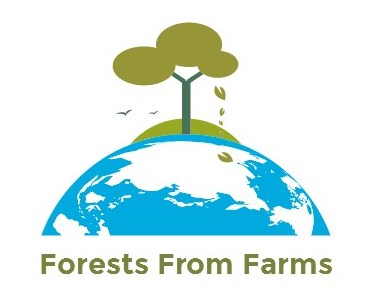
BLOG 2020
The old blogs can be consulted
France, 28 August 2020
Our New Friend
A green Whip Snake https://en.wikipedia.org/wiki/Green_whip_snake
France, 1 August 2020
A genetta, rare and protected species @ Forestsfromfarms
France, 29 July 2020
Participation of the association Forests From Farms to the Fitnes Check of the EU rules concerning animal welfare
France, 23 July 2020
Mediterranean Tree Frog @FFF
France, 2 July 2020
Colours of summer @FFF
France, 13 June 2020
Newly born faon at Forests From Farms
France, 2 June 2020
The best images of 2019 at Forests From Farms
Taken with our hidden cameras. With in leading roles: Roe deer, boar, coypu, geese (our own domesticated ), a fox, a badger, a weasel, a buzzard and other birds... This is Part1 (From January to June). Part 2 (June to December) will be published soon.
France, 25 Mai 2020
Our Action Published in the independent magazine for the environment "Reporterre"
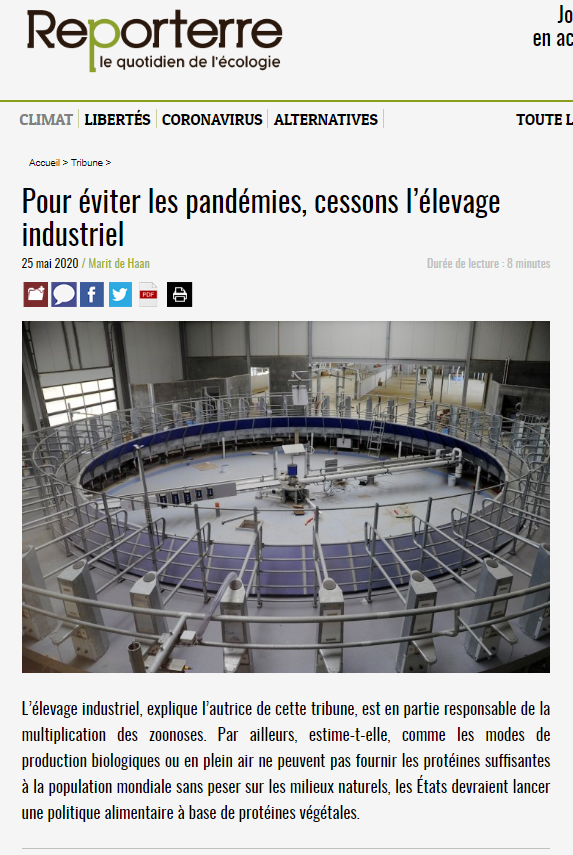
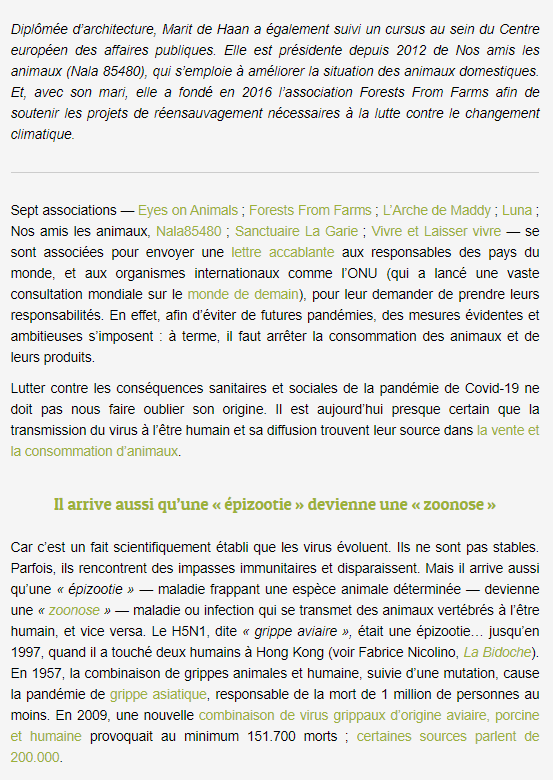
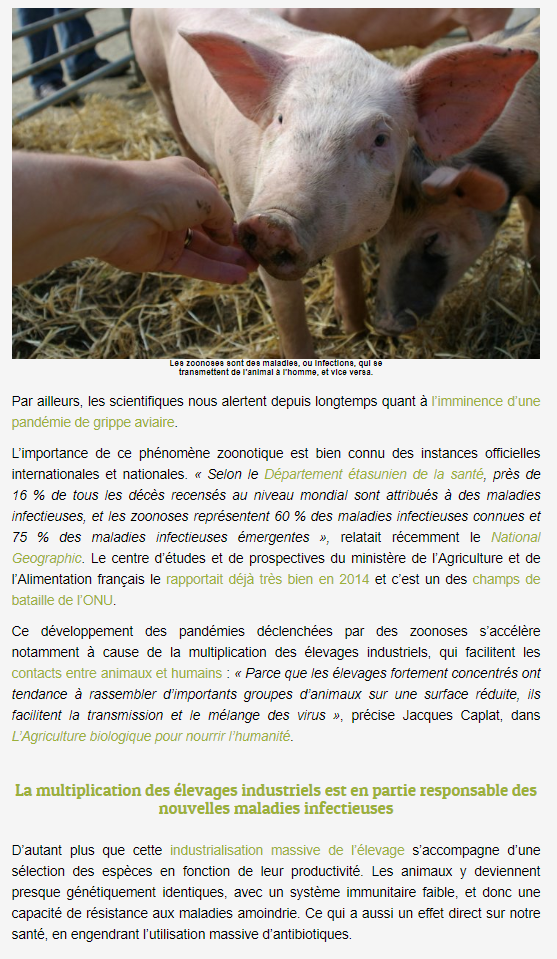
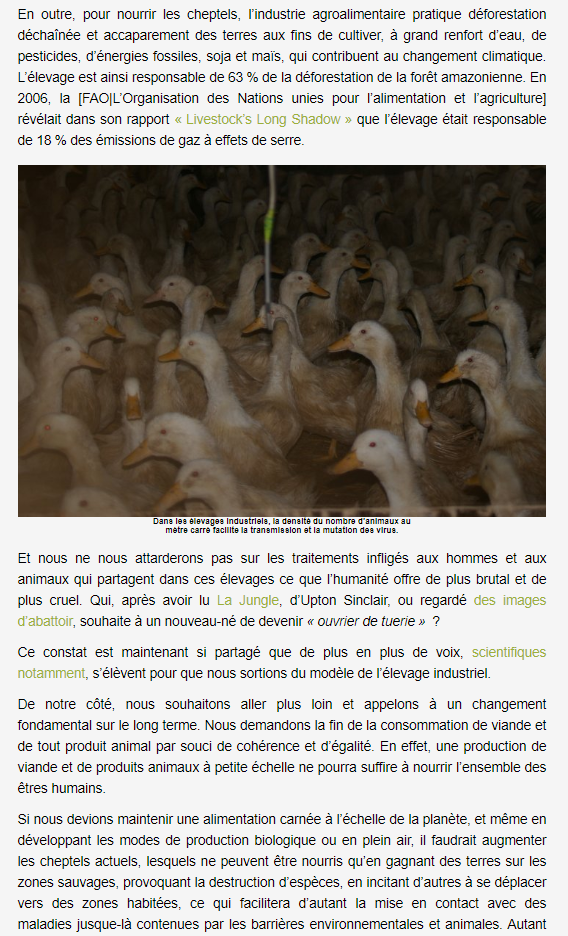

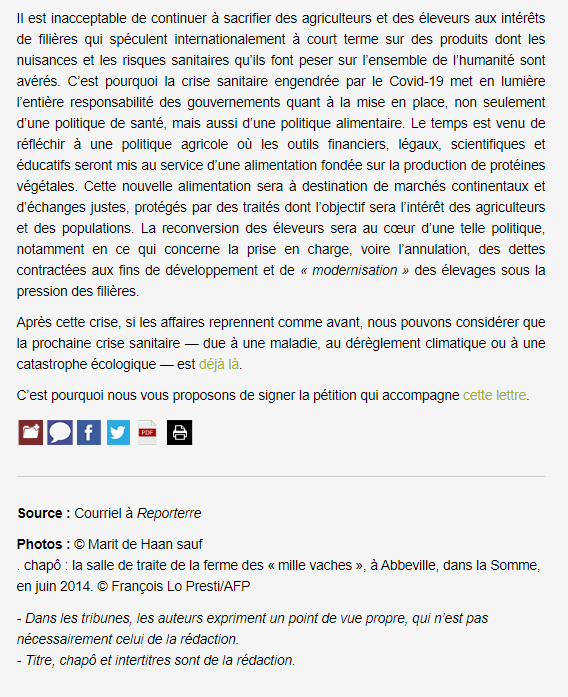
France, 17 May 2020
The Forest at Forests From Farms is taking shape
France, 1 May 2020
Letter to all heads of States and their governments about pandemics and the consumption of animal products
7 associations* have taken the initiative to send an unusual letter (listen to the video below) to heads of state and organisations like the EU, UN, etc., asking them to take their responsibility to prevent pandemics in the future by implementing some ambitious measures: in the long run, we must stop the consumption of animals and their products. At the moment, we are doing everything we can to fight the COVID-19 virus, but we must never forget where the virus actually comes from. There is little doubt that it comes from the consumption and sale of wild animals. COVID-19 is not the first pandemic. The largest was in 1918, when more than 50 million men, women and children died (almost the current population of France!) as a result of swine fever that also became transmissible from human to human through mutations. Hopefully we will not reach such a catastrophic number this time with the COVID-19 pandemic. But we are convinced that if we don't change our behaviour towards animals, there is a good chance that other pandemics will emerge. Scientists have been warning us for a long time. It is a call for drastic change in our society. We realise that but we think it is necessary. We invite other associations and organisations around the world to join us. Please sign and share the petition "Avian Flu, Swine Flu, SARS, COVID-19 Meat Kills" by clicking on the button below if you support this initiative.
Thank you!
*The associations who took this initiative are :
Eyes on Animals https://www.eyesonanimals.com/,
Vivre et Laisser Vivre https://www.facebook.com/chaminous/ ,
LUNA https://www.facebook.com/LigueUnivers... ,
L'Arche de Maddy https://www.facebook.com/larchedemaddy/ ,
Sanctuaire La Garie https://www.lagarie.fr/ ,
NALA85480 http://www.nosamislesanimaux.com/ and
Forests From Farms http://forestsfromfarms.org/France, 1 May 2020
Colours of snails
Each of them is a little architect that has created its own house for protection. The colours are magical.
France, 26 March 2020
Spring colors
These photos have been taken on our land. Weeds, flowers, plants, trees you name it. They are all beautiful.
France, 24 March 2020
Bees hard at work
France, 24 March 2020
Daisies galore good for insects
Freance, 24 March 2020
A bit of maintenance, but not too much. The rest is done by wildlife
France, 21 March 2020
Confinement COVID-19
Listen to the birds.... It is a lot quieter than usual without cars coming past.
France, 21 February 2020
At work at FFF
France, 24 February 2020
 .
.

Public Consultation Broiler Farm Bournezeau
Todat we sent in our opinion for the public consultation concerning an enlargement of a broiler farm in the area. Of course we are against this project. The text below is our argumentation in English. The participation we sent to the authorities was of course in French. The photos of the document are published on the FFF facebook page.
"On a small scale the project will have negative impacts on the environment due to the removal of 70m of hedge and the loss of over 4,000 square metres of agricultural ground, not the 3,000 square metres that the declarant says on page 126, classeur 2 ( see below)
The loss of the hedge is purely arbitrary. It appears that there is no technical reason for the new building to be built parallel to the existing one. If it was built at an angle then it would not be necessary to remove any hedge at all. See plan de masse annex 5. If the building was built at an angle then the amount of land required for access would be reduced, so reducing the amount of agricultural land that is lost.
According to page 180, classeur 2 "La remise en état du site ne signifie pas le retour à un état supposé initial, qui n’est lui-même que le résultat de multiples transformations ou aménagements réalisés par les générations précédentes, mais aux mesures prises pour que ne se manifeste plus aucun danger après cessation d’activité, et pour éliminer les déchets."
The argument is not tenable. The fact that the generations precedentes didn't clean up is no reason to continue to make a mess. Society evolves. The loss of agricultural ground is completely attributable to this project. It means the loss of over 4,000 square metres for many decades or centuries, for a project that even the declarant optimistically ( and irrealistically) thinks is viable for only 30-40 years
On page 82 of classeur 2 with regard to Nitrates in the water in the area, the demandant uses a carte of 2011 - 2013. We are now 7 to 9 years further. When you look at the carte on this site: http://carmen.carmencarto.fr/179/OSUR_NITR_SURF.map the situation with regard to Nitrates in the water in 2018 is a lot more pessimistic.
The demandant also seems to use old information with regard to the ZONES HUMIDES around the area of the farm. This map below (a screen print of the site Réseau Zones Humides in the area of Bournezeau and the farm ) http://sig.reseau-zones-humides.org/visualiseur/?zoom=7&lat=6603713.0374267&lon=346329.34961873&idlyr=13003 shows the zones humides in bleu and the red parcels are the lots of the farms for l'épandage / where manure is being spread.
Zones humides sig.reseau-zones-humides.org |
It seems to us that the farm is located close to some important zones humides, et donc nous doutons du classement "aptitude à l'épandage" par le Chambre de l'Agriculture.
Looking at the big picture...
According to the FAO in western Europe the production of 1 kg of chicken carcass is responsible on average for 6 kg equivalent CO2. This includes emissions from the farm, the production of feed, manure and energy used. The proposed extension is intended to produce over 480 tonnes of chicken. This implies over 2000 tonnes of equivalent CO2 emissions. Note that the average emissions of a typical citizen are around 5 tonnes per year.
How is it justifiable to allow one person to be possibly responsible for so many extra tonnes of emissions just for his own profit?
This project won't create any extra jobs, as the declarant intends to do all the work himself. In fact it may put at risk jobs in two or more smaller elevages which, in their turn, will be forced to grow. This is a continuation of the vicious circle of escalation in the size of elevages which has contributed to the drastic reduction in the number of jobs over the last few decades.
The declarant claims that
"4.10.2 IMPACT SUR L’AGRICULTURE
Le projet va emmener la suppression de terres agricoles (autour de 3000 m²)
correspondant à l’emprise future du projet. Le projet va cependant permettre de rendre pérenne cette exploitation et donc de l’ancrer dans le territoire pour plusieurs
décennies. Cela va permettre de maintenir l’activité agricole dans le secteur tout étant respectueux de l’environnement" page 126, classeur 2 .
However the average size of an elevage avicole is already over 2420 square metres and getting bigger every year. The declarant will have a total of 2780 square metres which is comprised of a new building of 1800 square metres and an old building of 980 square metres which " (Le bâtiment actuel) commence de plus à être vétuste." Page 8, classeur 1 Before long he may be obliged to invest in renovating this building otherwise his total elevage will be too small to be viable and even then it may soon be eclipsed by new bigger elevages.
The declarant says the aim of the project is "Afin de pouvoir vivre plus sereinement l’avenir...". Is this likely? It seems that the people guaranteed to have a avenir serein are the builders and the bank. They are guaranteed to be paid but the declarant will have at least 15 years of being at the mercy of events beyond his control. And the future for the French sector avicole doesn't look bright.
Many countries produce poulets a chair more cheaply as the ITAVI shows in its review. The Itavi also shows that the expected growth in production in the UE is only 0.4% per year. Is that realistic and will France be a country that shows growth? According to France Agri/Mer Poland and Spain are the countries showing growth.
The whole meat sector is being put under pressure:
There is an increase in the number of people reducing meat consumption. In the UK KFC introduced a vegan burger and sold 1 million within a month. If the most famous seller of fast food chicken is changing, surely the poultry sector must take this into account.
Can the world facing the threat of climate change and environmental damages continue to waste resources on feeding animals? According to ITAVI France produces 6.2 million of tonnes of food for poultry in order to produce 1.87 million tonnes of poultry. It makes more sense to grow crops that can feed people directly and so reduce the amount of ground needed for as agriculture and reduce the amount of pesticides, herbicides and fertiliser required.
Currently the agricultural sector is exempt from the emissions trading scheme. Yet we know that agriculture is responsible for a significant contribution to climate change. How much long before it too is subject to an emissions tax?
And what about the effects of Brexit? Exports from France to the world are already down. A loss of exports to the Royaume Uni will only exacerbate the problem.
It is a loss for the economy in general and the owner in particular for money to be invested in a project that will eventually become a stranded asset. Within a decade or so this farm is likely to become financially unviable as bigger farms will be more competitive. The money invested in it will be effectively lost to the economy. All around the Pays de loire and Bretagne there are old elevages that are no longer viable.
The declarant says , "Le fait de construire ou non le projet ne va pas faire évoluer de manière significative les différents critères évoqués puisqu’il y a déjà des bâtiments existants.
Si ce bâtiment ne se fait pas à cet endroit ou sur cette exploitation, il se fera ailleurs sur un emplacement (car la demande de production de volailles est présente dans le
secteur) qui lui peut être susceptible d’amener des nuisances pour l’environnement."
Page 38 classeur 2
This is, of course, a banal and trivial argument. If we allapplied this reasoning in our daily lives the world would descend into chaos. The fact that harm has already been done does not justify adding to it. The fact that someone else may cause harm is no excuse for causing the harm oneself.
For the reasons explained above Forestsfromfarms gives an unfavourable position on this project. We are aware of the pressures on farmers and believe that more should be done to help them. However encouraging them to grow bigger and bigger is not a long term solution. Instead the government should provide help to enable them to leave the sector but still have their future ensured. In the Netherlands, for example, the government gave compensation to the dairy farmers to reduce the size of their herds. The project was oversubscribed within days which shows that there was a need for it."
